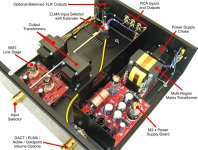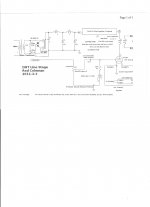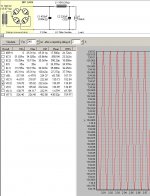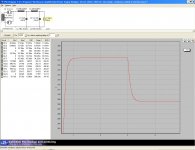DC filament (CLC circuit, C totally 10000 uf, L 200mH) is used for 71A, with good filtered negative supply for fixed bias. I guess hum from my plate choke. I did place 2 HT chokes and 2 filment chokes a little bit near anode choke and B+. next step is isolating all that choke in separate chassis.
Op point of 71A is 130-150V/ 10-11mA. I feel the sound a bit thin.
Could you show me your 71A schema ?
Here you are: 71a DHT pre-amplifier | Bartola Valves
I have learned and experienced a bit since this build so I'd probably improve the circuit used, however it sounded really nice and was dead quiet.
I used filament bias so no fixed bias here. Choke placement can be problematics sometimes as they pick hum easily. Do you have supply and preamp on same chassis? Many of us around here will recommend splitting preamp and supply on separate chassis.
I have my HT and LT supplies on a chassis lying on the floor. It's far off from the preamp
Hope this helps
Cheers,
Ale
Hi!
Try LCL instead on the filaments and be amazed
Requires higher voltage from the secondary of the filament transformer due to choke input.
Best regards
Thomas
I just drop in my friend who is using 300B ampli Audio Kits serie 2. He change LM1085 regulator for CLC filament. Wow, the sound get more bass, richer tone, sparkle... It's worthy
Advantage of a 2nd stage will be to lower the output impedance, easier way to drive long distance cables. Old German studio gear - Klangfilm etc. - used to have output impedances of 60Ω .
BR, Joao
I've got a pair of OPT from L2 preampli of Audio Note kits like the photo below. This one has ratio 25V:1V . I did check this ratio by means of supplying some voltages on the secondary winding . My friend say it has 200H, but my manual Peak teach 2615 shows only 50H at scale of 120Hz. So I don't know how its impedance is, and how is real Henry. wonder if it is suitble for tube 26.
Attachments
Last edited:
Hi tcqanh,
If your plate choke or OPT is 50H you can always consider the 4P1L instead of the 26. Or 71A, though that will give you a lot less gain and I also think maybe not so good sound. You might like to try different solutions that work for the transformers you have available and then compare the results. The 26 really needs 150H and upwards to get a clean sound, or it will start getting a bit mushy.
Also, Thomas is right about LC rather than CL. With something like what I've been using, a 280mH choke input (or a small cap like 220uF), you get a nice clean supply with low ripple, and you can further refine that.
If your plate choke or OPT is 50H you can always consider the 4P1L instead of the 26. Or 71A, though that will give you a lot less gain and I also think maybe not so good sound. You might like to try different solutions that work for the transformers you have available and then compare the results. The 26 really needs 150H and upwards to get a clean sound, or it will start getting a bit mushy.
Also, Thomas is right about LC rather than CL. With something like what I've been using, a 280mH choke input (or a small cap like 220uF), you get a nice clean supply with low ripple, and you can further refine that.
Last edited:
Hi tcqanh,
If your plate choke or OPT is 50H you can always consider the 4P1L instead of the 26. Or 71A, though that will give you a lot less gain and I also think maybe not so good sound. You might like to try different solutions that work for the transformers you have available and then compare the results. The 26 really needs 150H and upwards to get a clean sound, or it will start getting a bit mushy.
Andy is correct, the AN uses a 5678 and it has a plate resistance of 1.5 ~ 3k (depends on operanting point). If you will use that output transformer you should use one of the tubes he recommends - or you use IDHT 5687, but we discuss here DHT line stages.
Attachments
Hi Magz,
Any advantage with using Music rails on the filament supply before Rod's regulator? Any difference in sound without it?
Cheers!
Ravi
I did not check with/without. I've used them before in an EQ and another preamp and they provided measurable noise reduction, so I just put them in this time without measurement. There is a thread on the "everything else" forum here with some results and measurements.
Bybee stuff is controversial but the music rails at least have been shown to do something measurable.
Hi Felipe,
With a genuine choke-input filter, the rms current in the secondary will only be a little higher than the dc current.
But it is best to have a good margin, so that the transformer runs cool, and so that you can experiment with higher anode current, or different DHT, etc.
E.g. For a Line amp with 100V on the anode, and (say) 35mA dc draw maximum in total (anode current, plus an allowance for divider or bleeder, or gas-discharge regulator tube) -
choose Choke-input filter, 160V rms trafo to get about 135V with the attached circuit.
The rms current in the secondary is about 37mA. Total Trafo VA is about 6VA. It would be better to choose something like 50VA to keep the regulation reasonable (ie loaded voltage versus unloaded voltage).
choose a transformer with an electrostatic shield, or a "split-bobbin" (dual-bobbin) EI construction. Cheap Toroidal not recommended, they will let the noise in to your amp.
With a genuine choke-input filter, the rms current in the secondary will only be a little higher than the dc current.
But it is best to have a good margin, so that the transformer runs cool, and so that you can experiment with higher anode current, or different DHT, etc.
E.g. For a Line amp with 100V on the anode, and (say) 35mA dc draw maximum in total (anode current, plus an allowance for divider or bleeder, or gas-discharge regulator tube) -
choose Choke-input filter, 160V rms trafo to get about 135V with the attached circuit.
The rms current in the secondary is about 37mA. Total Trafo VA is about 6VA. It would be better to choose something like 50VA to keep the regulation reasonable (ie loaded voltage versus unloaded voltage).
choose a transformer with an electrostatic shield, or a "split-bobbin" (dual-bobbin) EI construction. Cheap Toroidal not recommended, they will let the noise in to your amp.
160V 50VA is not a typical catalogue transformer (eg off-the-shelf Hammond), so a custom wound version is usually needed.
Industrial Control Panel Trafos work really well, like this one from our local company:
50 VA
If Modena, Italia is near, please try Ideomat
Sommario visuale trasformatori monofase
Many Countries have these, and they can usually wind whatever you need. The shipping costs almost as much as this 50VA trafo, so it's best to find a local winder.
but please check that a split-bobbin is used!
Industrial Control Panel Trafos work really well, like this one from our local company:
50 VA
If Modena, Italia is near, please try Ideomat
Sommario visuale trasformatori monofase
Many Countries have these, and they can usually wind whatever you need. The shipping costs almost as much as this 50VA trafo, so it's best to find a local winder.
but please check that a split-bobbin is used!
Thanks Rod, I tried to use PSUDII but can't get the hybrid rectifier with two UF4007 + AZ1
You can just use the vacuum-brdige-rectifer model, it is quite close. Or use full-wave, the difference is less than the other errors (winding resistance, regulation etc)
I'm using a Hammond 374AXP for my B+ supply (just call me Mr Overkill). Very nice potted, steel-cased transformer, dead quiet. PSUD is attached. Choke input supply with two Lundahl LL1685 17H.
The 122.7uF final cap takes into account 100uF plus 2.7uF bypass plus 10uF per channel in the preamp box. I have what's in the PSUD in the PSU box going to the preamp box and splitting per channel to a 10uF cap, CCS at 29.5mA, VR150-VR75 bypassed with .047 Jensen copper foil, plate CCS at 7mA (runs about 132V on the plate). Sounds nice...
The 122.7uF final cap takes into account 100uF plus 2.7uF bypass plus 10uF per channel in the preamp box. I have what's in the PSUD in the PSU box going to the preamp box and splitting per channel to a 10uF cap, CCS at 29.5mA, VR150-VR75 bypassed with .047 Jensen copper foil, plate CCS at 7mA (runs about 132V on the plate). Sounds nice...
Attachments
Funny thing is...so far I've tried the RCA 5R4GY, the Tung-Sol 5U4GB, the Mullard GZ33 and the RCA 5Y3GT - the lowly 5Y3GT sounds the best of these with a nice balance of warmth and detail. The 5R4GY has incredible detail but is a bit harsh on the highs.
With all that stuff between the rectifier and the tube, there is still a difference in the sound, even though the 26 CCS is running at 7mA and 132V in either case...
With all that stuff between the rectifier and the tube, there is still a difference in the sound, even though the 26 CCS is running at 7mA and 132V in either case...
Last edited:
Funny thing is...so far I've tried the RCA 5R4GY, the Tung-Sol 5U4GB, the Mullard GZ33 and the RCA 5Y3GT - the lowly 5Y3GT sounds the best of these with a nice balance of warmth and detail. The 5R4GY has incredible detail but is a bit harsh on the highs..
There's nothing lowly about the 5Y3!! This is the same tube as the revered 80, but with an octal base instead of UX4. It's probably the best preamp tube (with the 80) unless you go into expensive stuff like the mesh plate German ones like AZ1. I use it or the 80 myself when I'm not using my small stock of mesh plate AZ1s
I use the 5R4GY for higher power duties - I prefer it to any of the GZ series, though it does have a larger voltage drop. But I tend to use two 6BY5 in parallel with a hybrid bridge for 200mA and over. Sounds very nice to me.
http://www.mif.pg.gda.pl/homepages/frank/sheets/049/6/6BY5GA.pdf
Last edited:
Yes Andy, all true, but the 5Y3 doesn't seem to come up in most of the online discussions of best rectifier tube. It's always the GZs, 5R4s, 274B etc. Seems like the 5Y3 doesn't get the hype the others do, but it sounds great! Still have to try my 6106 (5Y3 but it's IDH...), 5Y3WGTA and 274B (Valve Art not WE).
- Home
- Amplifiers
- Tubes / Valves
- #26 pre amp



